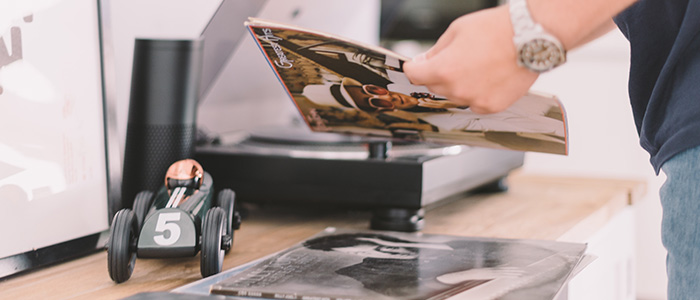- 03.09.2017
- lharper
- How-To Music Tech"knowledge"y
How to take care of your vinyl records

How to take care of your vinyls
With vinyl sales at their highest since 1996, suppliers are struggling to keep up with the demand. While there are varying theories on why this surge is happening, one thing is certain: vinyl is back. Audiophiles have long hailed vinyl as superior to digital playback, but it has taken a while for everyone else to catch up. Vinyl albums have a much greater dynamic range than their digital equivalent and allow you to hear the music as it was actually recorded. There are many listening benefits to vinyl, but in order to maintain the integrity of the music, some maintenance is required. Here are some tips to make sure that you keep your records in the best shape possible.
Storage
Storage is the first step in proper care. Dirt and dust are a vinyl's worst enemy and it is important to keep your records covered in order to minimize damage to the vinyl and/or to your turntable’s stylus. Always place your vinyl back in its sleeve when you are done playing it, don’t just set it down. When not in use, we recommend that you store your vinyl albums in a space that is not subject to unusual temperatures or humidity. Temperature fluctuations and excess humidity will cause warping, which in turn distorts your sound.
While better than nothing, the cover that your vinyl comes in will do little to actually protect the record from static, dust, or dirt. We suggest instead going with a polyethylene lined sleeve, which is soft and will protect your record from the elements. You should also avoid storing your vinyls horizontally. The weight of the records pressing together damages the grooves and will almost always cause warping.
Record Handling
One of the easiest ways to prevent dirt and dust from getting on your records is to pay attention to how you handle them. When transferring your vinyls to and from your turntable, avoid touching any part that holds information (the grooves) and instead pick them up by the edges and the inner label. An easy extra step is to use a carbon fibre brush to remove any surface dust before and after playing your record. We recommend taking advantage of your dust cover if your turntable comes with one. This will minimize airborne dust that collects on the record surface.

Cleaning your record
As previously mentioned, fibre brushes are a great way to remove surface dust and they should definitely be used before any kind of wet-cleaning. Failing to do so will enhance the risk of pushing dirt farther into the grooves or moving it around and causing scratches to the surface. There are several methods for cleaning your vinyl, but the most effective method is vacuum based cleaning. These systems work by holding your record on a platter while a vacuum sucks up the applied cleaning solution. These systems, although extremely effective, can be a bit pricey and take up a lot of space. Luckily, there are plenty of other options if you don’t want to make such a large investment.
More affordable options include manual record cleaning machines and hand-washing kits. One of our favorites is the Spin-Clean Starter Kit System. This simple system makes it easy to clean your records with just water and the included solution. If you only have a few records and don’t want to invest in an entire kit, you can still achieve good results from hand-washing your vinyls. The best way to do this is to place your vinyl on a soft, lint-free surface and apply a mixture of record cleaning solution and distilled water. Try to avoid tap water because the mineral deposits may actually damage your album. Make sure to clean in the direction of the grooves and use a separate cloth to dry your vinyl once it’s been cleaned.
Vinyls provide a warm sound that you just can’t get from digital. Maintaining that vibrant sound can take a little upkeep, but it is definitely worth it. Whether you have been an audiophile for years or you’re just getting started with turntables, Gramophone has everything you need to enjoy your records to the fullest. If you have any questions about how to get started with vinyl or how to take care of the vinyls you already have don’t hesitate to contact us or visit one of our locations to talk to our experts.

